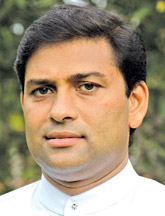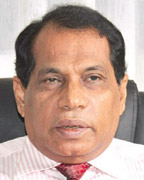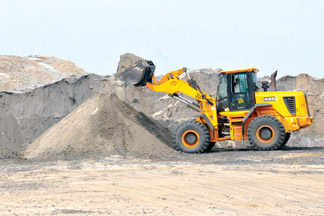|
Turnaround within three years:
Lanka Mineral Sands, now a profit-making venture
By L.S. Ananda WEDAARACHCHI
|

Minister Dayashrita Tissera |
Lanka Mineral Sands Ltd., (LMSL) has paid Rs. 1,700 million as
dividends to the Treasury this year, said LMSL Managing Director Dishan
Gunasekera.
The upward trend in prices for Mineral Sands resulted in the company
earning a recorded profit, Gunasekera said in an interview with the
Sunday Observer last week.
Excerpts of the interview:
Q: LMSL has been transformed into a profit-making venture
within a span of three years. Could you explain how this turnaround took
effect?
 |
 |
| Chairman Dr.
Willy Gamage |
Managing
Director, Dishan Gunasekera |
A: The tender procedure enabled the company to receive the
highest prices for its products. On the other hand, the company's
employees were motivated to meet challenges in their fields and thereby
help increase productivity and promote positive thinking. Workshops and
training programs were conducted for the staff and their stations. New
recruits were also given a four-day residential training course.
The far-sighted policies and marketing strategies under the guidance
of State Resources and Enterprise Development Minister Dayashrita
Tissera and Secretary - Chairman LMSL Dr. Willy Gamage resulted in the
success of the company. Planning and teamwork are the secrets behind
these achievements.
Expansion program
Q: What is the expansion program for the mineral sand plants
from Pulmoddai to Mullaitivu in the Eastern Coast?
A: The four plants at Nayaru, Kokkilai, Poduwakattu and
Periyakarachchi pump sands into the Yan Oya and Periyakarachchi plants
for processing the minerals.

Pulmoddai - loading mineral sand |

Yan Oya development work |
 |
| Collecting
mineral sand |
These two plants are important in separating mineral sands from
normal sands.
Although some foreign business magnates were interested in purchasing
these plants, the Government did not want to part with these "gold
mines". The renovation and upgrading of Pulmoddai and Periyakarachchi
mineral processing plants, costing US $ 40 million, had been undertaken
by an Australian company. It has been estimated that an annual profit of
US $ 50 million could be earned after the completion of this plant.
The Yan Oya mineral processing plant will also be renovated. An
annual profit of US $ 100 million could be earned after the completion
of the second plant at Yan Oya.
Production process
Q: Could you explain the production process of mineral sand?
A: Sea waves bring minerals from the sea bed to the beach.
Truck-loads of sea sand are brought to the Mineral Sand upgrading
plants, where mineral sand is separated from sea sands.
Later, mineral sand will be processed at the mineral processing
plants at Yan Oya and Pulmoddai. It is a highly sophisticated process.
Ilmenite, Rutile, Zircon, Hiti Ilmenite and Garnet-Monazite stockpiles
are produced at the Pulmoddai and Yan Oya mineral processing plants.
Q: Can you explain the demand for mineral sand by
industrialised countries?
A: Mineral sands such as Ilmenite, Rutile, Zircon, Hiti
Ilmenite and Garnet are used as raw materials to manufacture paints,
paper, ceramics and medicinal products. Titamium Dioxide - T10-2 is
manufactured using Ilmenite.
Q: What are the other countries that are leading producers of
mineral sand?
A: Mineral sand deposits are available in the USA, Australia
and China where the mineral sand content in sea sand is around three to
five percent while it is more than 80 percent in Sri Lanka's sea sand.
What Sri Lanka needs is advanced technology to develop the industry.
Negotiations in this regard are conducted with regional countries,
Europe and USA.
Industrial Act
Q: When did mineral sand production commence in Sri Lanka?
A: The Mineral Sand Corporation was set up in 1960 under the
Industrial Act of 1957. The Japanese government provided technical and
scientific assistance for the project.
Even the first shipment of Ilmenite was exported by a Japanese
company named Ishihara Sino Kaisa in 1962. The Asian Development Bank
provided assistance in 1978 for the development of the industry. While
the industry was in rapid progress, earning billions in foreign exchange
through the export of mineral sand, the LTTE brought the operation of
the factory to a standstill in 1983.
The factory remained closed for nearly 30 years and there was an
attempt to sell the factory during the UNP regime in 2001. The Ministry
of State Resources and Enterprise Development was set up primarily to
reactivate defunct State enterprises such as LMSL.
|


